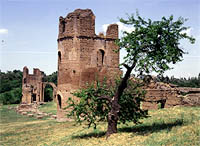|
|
 |
|
Via Appia Antica |
|
written
by Anabelle Sutcliffe / 07.12.2004 |
|
|
| |
Site Location |
| |
Via Appia Antica is the part of Via Appia abandoned in the Middle Ages in favour of Via Appia Nuova which linked the main road to the south with the Lateran. The two roads join in Frattocchie near Albano. Via Appia Antica is split by the Circular Road of Rome near Torre in Selci at the VII mile of Via Appia.
|
| |
|
| |
|
| |
Site History |
| |
The Via Appia Antica (312 BC)was named after its builder, the Consul Appius Claudius Caecus. This direct route south to Naples and the "Boot of Italy" eventually reached Brindisi, 330 miles to the South-East. From that port on the Adriatic, Rome's legions, after a two-week march from the capital, sailed off to conquer the eastern part of the Empire.
Via Appia "Regina viarum" (Queen of Roads) was surprisingly straight, and superbly surfaced with massive blocks of volcanic stone. You can still find patches of these paving blocks that were originally flat, but now have grooves worn into them by carriage wheels.
|
| |
|
| |
|
| |
Elements of Interest |
| |
This site is one that brings to mind the phrase, "all roads lead to Rome". The roads had to be wide enough for five Roman soldiers to march abreast, or two carriages to pass each other.
The Romans used to bury their dead outside the city walls. Unlike the modern practice of chosing a quiet place for our eternal rest, the Romans liked to be buried alongside a busy road like the Via Appia so as to be remembered by the passers-by. There were many types of tombs along the Via Appia Antica, determined by the social status of the deceased.
|
| |
|
| |
|
| |
Analyze Image |
| |
| |

|
|
| Via Appia Antica |
|
| |
|
This image reveals just how ancient this site really is. Despite its age however, the stone is in surprisingly good standing.
|
| |
|
| |
|
| |
Site Questions |
| |
How large is the Via Appia Antica?
How was the stone transported and laid down when the Via Appia Antica was built?
|
| |
|
| |
|
|
 |
|
